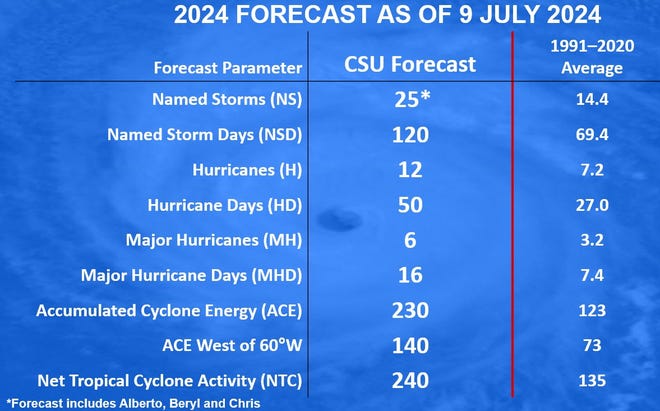Colorado State University meteorologists have updated their forecast for the 2024 Atlantic hurricane season.
The news is not good.
Forecasters raised their forecasts, continuing to predict an “extremely active” season with 25 named storms. That's two more storms than previously forecast.
➤ Interactive map: Track active storms
“We expect a well-above-average chance of major hurricane landfall along the continental U.S. coastline and Caribbean,” the forecast said, adding that “Hurricane Beryl is a deep tropical Category 5 hurricane that may also be a precursor to hyperactivity. .
Every forecast for the 2024 season predicts an above-normal season, with AccuWeather forecasters even saying the record of 24 named storms in 2020 is likely to be broken.
What's Colorado State University's July forecast for the 2024 Atlantic hurricane season?

Here’s what Colorado State University forecasters are predicting for the season in their July 9 forecast:
- Named Storms: 25 (average 14.4)
- Hurricanes: 12 (7.2 average)
- Major hurricanes: 6 (average 3.2)
How do Colorado State University's latest predictions compare to previous predictions?

Here's a side-by-side comparison of Colorado State University's July forecast for this hurricane season and the forecast released on June 11.
- Named storms in June and July: 23, increased to 25
- Hurricanes, June and July: 11, increased to 12
- Major hurricanes in June compared to July: 5, increased to 6
What is the chance that at least 1 major hurricane will make landfall in Florida, USA?
“The likelihood of a major hurricane making landfall in the United States is estimated to be well above its long-term average,” Colorado State University said.
A major hurricane is a hurricane of Category 3 or above. Category 3 storms have sustained winds of at least 111 mph.
Colorado State University predictions:
- Entire continental United States coastline: 57%
- The average from 1880 to 2020 is 43%
- U.S. East Coast, including the Florida Peninsula (south and east of Cedar Key): 31%
- The average from 1880 to 2020 is 21%
- Gulf Coast from Florida Panhandle (west and north of Cedar Key) west to Brownsville: 38%
- The average from 1880 to 2020 is 27%
What is the chance that at least 1 major hurricane will pass through the Caribbean Sea?
- 62%
- The average from 1880 to 2020 is 47%
Hurricane Beryl could be a 'harbinger' of what to expect this year
“Hurricane Beryl is a deep tropical Category 5 hurricane that may also be the harbinger of a hyperactive season,” Colorado State University said in its forecast.
“Deep tropical hurricane activity in the tropical Atlantic and eastern Caribbean, such as what we see in Beryl, is often associated with hyperactive seasons.”
National Hurricane Center Forecast for the 2024 Hurricane Season
National Hurricane Center: The National Hurricane Center predicts an 85% chance of an above-normal season, a 10% chance of a near-normal season, and a 5% chance of a below-normal season.

NHC forecasters predict:
- 17-25 Named Storm
- Category 8-13 hurricane
- Category 4-7 hurricane
AccuWeather Forecast for the 2024 Season
accurate weather: AccuWeather predicts that this season has the potential to break the previous record of 30 named storms in a single season set in 2020.

- 20-25 Named Storm
- Category 8-12 hurricane
- Category 4-7 hurricane
- 4-6 Direct impact on the United States
Why is the 2024 hurricane season expected to be so busy?
Signs as early as February are making forecasters nervous, predicting it will be an active season due to a combination of La Niña conditions and record warm water temperatures in the Atlantic basin. When it comes to hurricanes, the two combined pack a powerful punch.
“La Niña typically increases Atlantic hurricane activity,” Colorado forecasters said. La Niña lacks the wind shear associated with El Niño, which can help tear apart developing storms or prevent others from intensifying.
“Sea surface temperatures in the eastern and central Atlantic are currently at record warm levels and are expected to remain well above average during the upcoming hurricane season.”
Colorado State University says these warm Atlantic waters provide a favorable environment for hurricanes to develop and intensify.
What is the average number of hurricanes during hurricane season?
According to the National Hurricane Center, the Atlantic hurricane season averages 14.4 named storms, based on the 1991 to 2020 average.
Colorado State University says the average number of hurricanes is 7.2 and the average number of major hurricanes is 3.2. This makes the 2024 forecast well above average.
The first named storms usually form in mid-to-late June, the first hurricanes tend to form in early to mid-August, and the first major hurricanes form in late August or early September, although there are exceptions to all of these.
Countdown: When will the 2024 hurricane season end?
The 2024 Atlantic hurricane season begins on June 1 and will end on November 30, although storms can and have occurred outside of these dates.
Hurricane Tracker: How to Track Tropical Storms, Hurricanes
Can't see the map? Open in a new browser.
When is the peak of hurricane season?
The peak of the season is September 10, with the most activity from mid-August to mid-October, according to the hurricane center.
Florida’s next sales tax holiday is coming in August
“Coastal residents are reminded that all it takes is one hurricane landfall for them to have an active season,” Colorado State University said.
“No matter how much activity is expected, you should be prepared for every season.”
Florida will conduct a second two-week hurricane stockpile period from August 24 to September 6. Save on hurricane supplies like batteries, lanterns, pets and cleaning supplies.
